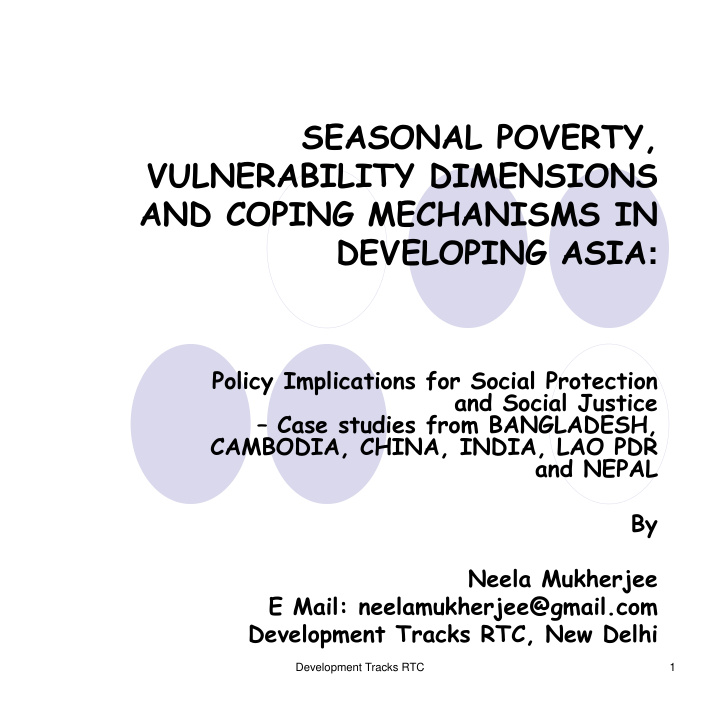



SEASONAL POVERTY, VULNERABILITY DIMENSIONS AND COPING MECHANISMS IN DEVELOPING ASIA : Policy Implications for Social Protection and Social Justice – Case studies from BANGLADESH, CAMBODIA, CHINA, INDIA, LAO PDR and NEPAL By Neela Mukherjee E Mail: neelamukherjee@gmail.com Development Tracks RTC, New Delhi Development Tracks RTC 1
Paper based on case studies from 6 Asian developing countries – BANGLADESH, CAMBODIA, CHINA, INDIA, LAO PDR and NEPAL Draws upon comparative field lessons for policy Based on PRA/PLA - seasonal calendars, interviews and group discussions Development Tracks RTC 2
KEY ISSUES, LESSONS AND POLICY DO-ABLES - CROSS-COUNTRY COMPARISONS Food Security is the Bottom-line – Food deficit periods are highly correlated with Seasonality Seasonal Forces make Livelihoods Vulnerable - India and Nepal - Livelihoods diversification helps to reduce vulnerability Women and Women-Headed Households most Affected – Cases from Bangladesh Cambodia, Laos, Nepal and India - women and FHHs most affected -Targeted seasonal safety net Elderly Women’s Plight – Grain transfers and cash transfers guaranteed by public institutions Development Tracks RTC 3
KEY ISSUES, LESSONS AND POLICY DO-ABLES - CROSS-COUNTRY COMPARISONS (Continued) Feminization of Poverty and Appropriateness of Programmes – Customized scheme - seasonal health safety net for FHHs/women/children Seasonal Migration- a Coping Strategy helps Men - China - felt need amongst migrants for capacity building - New schemes required to protect interests of the migrants Disposable Cash and Seasonal Migration - Disposable cash helps repay debts, repair dwelling, buy new assets, meet social obligations, family commitments and save Development Tracks RTC 4
KEY ISSUES, LESSONS AND POLICY DO-ABLES - CROSS-COUNTRY COMPARISONS (Continued) Higher Incidence of Human Disease and Livestock Disease -Important to recognize seasonality patterns of human health and livestock - Provide health education, livestock insurance on easy terms and affordable preventive and curative health services Accessing Wild Food and Commons in Deficit Periods – Cambodia, China, Laos, India and Nepal -Important for natural resource policy Involvement and Empathy of Local Institutions and Governance – Lao PDR case - Social institutions support coping with vulnerability - India and Nepal – local functionaries when effective help mitigate seasonal impacts - Variability to increase with climate change – Increased capacity to cope with shocks and stresses – Local capacity building Development Tracks RTC 5
KEY ISSUES, LESSONS AND POLICY DO-ABLES - CROSS-COUNTRY COMPARISONS (Continued) Integrated and Sustained Interventions have Better Value – Cases from India and Nepal show -Integrated and sustained interventions provide better support Corruption eats into Social Protection and Hampers Social Justice – India Corruption study estimate 1 of every 3 BPL households paid bribes in availing one or more of the 11 public services in 2007-08 -In NREGS, one- fourth of BPL households bribed a local “public representative” though one of the lowest - more of such reporting required Recognition of Local Knowledge – Establishing communication channels with poor women Support towards Ethnic Minorities – Often most neglected groups/communities and most affected by seasons Development Tracks RTC 6
Case studies from 6 countries indicate: - Fresh thinking on seasonal safety nets - New capacity building Seasonal Safety nets: To ensure seasonal food security for women and children Livelihoods diversification and support for women and elderly based on the spot-analysis Pro-poor natural resource policies for deficit seasons – Investment in human resources – Capacity building for seasonal migration – Institutional capacity building to tackle seasonal poverty Development Tracks RTC 7
Recommend
More recommend